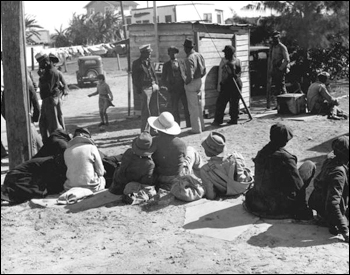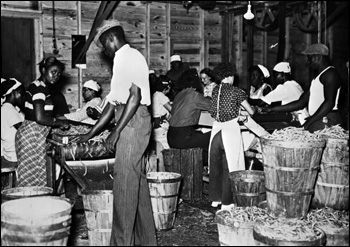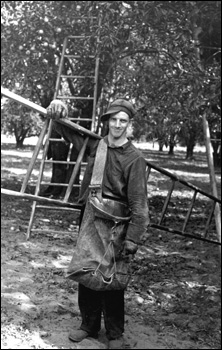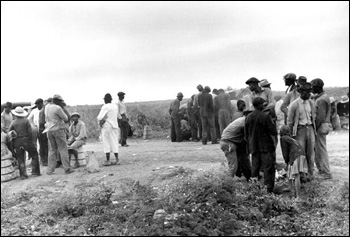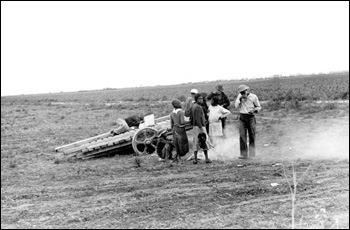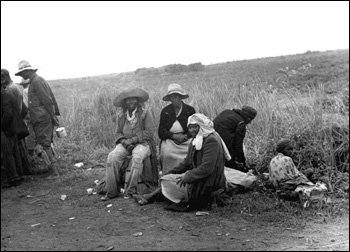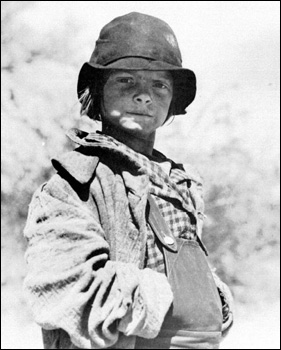Photo Exhibits
Photo exhibits spotlight various topics in Florida history, and are accompanied by brief text intended to place selected materials in historical context.
Migrant Workers During the Great Depression in Florida
Working & Waiting
Going Where the Work Is
Like other states that drew displaced workers during the Great Depression, Florida sometimes used police and armed guards on the state's borders to limit what state and local officials feared could have become an overwhelming number of indigent poor.
Migrant workers and their families would wait for the chance to enter the border legally or find other ways to secretly enter the state and make their way south to where the jobs were.
For those migrant farm laborers who did find jobs picking vegetables and fruit in packing plants, pay could still be intermittent and workers needed every penny just to feed their families and pay rent.
Securing steady work as a migrant laborer often entailed a lot of waiting—for the chance to ride out to the fields where the day's picking would be or to finally receive their pay after a long day’s or week’s work.
Migrant workers did, however, find their way into Florida by the tens of thousands. They made their way to the drained marshlands south of Lake Okeechobee and along the edges of the Everglades in one of the few regions of the country still able to sustain profitable farming operations before World War II.
They worked picking vegetable crops such as beans, tomatoes and potatoes, in canning factories and packing plants, and at numerous other strenuous manual labor jobs, as well as picking citrus that had been unaffected by the Mediterranean fruit fly.
White and black, men and women, and people of all ages took advantage of the agricultural work available in Florida after finding themselves unable to make a living back home.
Migrant workers waiting for a truck to take them to the bean fields: Lake Harbor, Florida (1939)
Image Number: RC02697
Migrant workers at a bean canning plant: Dania, Florida (1937)
Image Number: N032213
Canning plant employees grading beans. Dania, Florida. Many of these workers are migrants.
Migrant orange picker holding ladder: Polk County, Florida (1937)
Image Number: RC02707
Change Comes Again
The thousands of migrant workers used whatever resources they could muster—mainly their own sweat and perseverance—to find food and shelter in order to make it though the tough times while preserving their dignity.
By the early 1940s, large farming operations periodically asked the state government to allow more migrant farm workers to cross the border in order to keep wages low, and companies actively recruited workers from other southern states even while the state of Florida was discouraging migrants.
When the United States military mobilization intensified after December 7th, 1941, thousands of jobs in war industries opened up as former migrant workers found new opportunities at industrial construction sites or entered military service.
Shipyards and naval and air force bases in Jacksonville, Eglin Air Force near Pensacola, Opa-locka near Miami, Camp Blanding near Starke and Camp Gordon Johnston in Carrabelle drew former agricultural workers from South Florida as well as new workers from around the nation.
Migrant agricultural workers waiting to be paid: Homestead, Florida (1939)
Image Number: RC02708
Migrant agricultural workers waiting to be paid: Homestead, Florida (1939)
Image Number: RC02709
Migrant vegetable pickers waiting to be paid: Homestead, Florida (1939)
Image Number: RC02705
Migrant laborer (193-)
Image Number: PR07087

 Listen: The Latin Program
Listen: The Latin Program